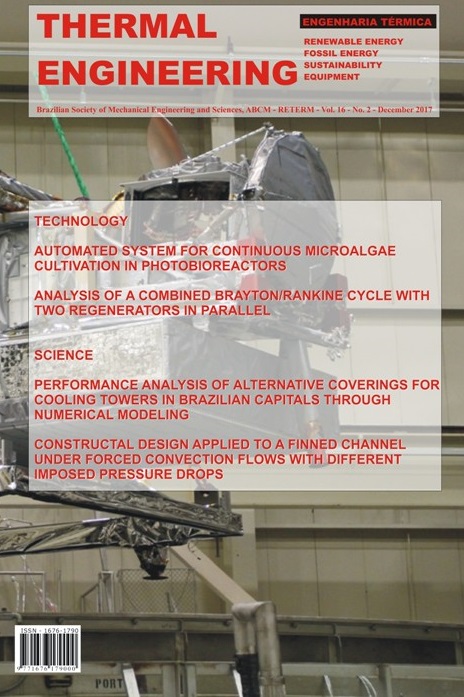CONSTRUCTAL DESIGN APPLIED TO A FINNED CHANNEL UNDER FORCED CONVECTION FLOWS WITH DIFFERENT IMPOSED PRESSURE DROPS
DOI:
https://doi.org/10.5380/reterm.v16i2.62216Keywords:
numerical simulation, constructal design, finned channel, forced convection, Bejan numberAbstract
This paper aims to numerically study the heat transfer in a two dimensional finned channel under laminar, incompressible and forced convective flow with adiabatic walls. The main purpose is to maximize the convection heat transfer by changing the fin’s dimensions by means of Constructal Design. Numerical computations are performed for different Bejan numbers ranging from 0.182 up to 18.2. For all simulations the Prandlt number is kept constant, Pr = 0.71. The fluid motion throughout the channel is caused by imposition of pressure difference between inlet/outlet surfaces. Concerning heat transfer, it is caused by the difference of temperature between the inlet stream of fluid and the heated fins placed at the channel surfaces. The first fin is positioned in the lower surface of the channel while the second one is placed in the upper one. The problem is submitted to three constraints, the channel area (H × L), area of two fins and occupancy areas for the fins. It is considered here that both fins have the same fraction area (ratio between the fins and occupancy areas) f = 0.2. The problem is submitted to three degrees of freedom: H/L (ratio between height and length of channel), H3/L3 and H4/L4 which represent the ratio between the height and length of the first and second fin, respectively. Here, the second fin remains unchanged, being its dimensions H4/L4 = 2.0, whereas the first one is free to modify its dimensions, H3/L3. The channel dimensions are also constant. The solutions are sought using the conservation equations of mass, momentum and energy being these ones discretized through the Finite Volume Method (FVM). Results showed the importance of Constructal Design application for thermal improvement of the problem. Thermal efficiency differences of 5 times where achieved when comparing the best and worst cases. Other important observation is concerned with the effect of ratio H3/L3 over heat transfer ratio (q) which varied significantly from a case where a pressure drop is imposed in the channel to other case where the driven force is caused by imposition of velocity field at the channel inlet.
Downloads
Published
How to Cite
Issue
Section
License
Direitos Autorais para artigos publicados nesta revista são do autor, com direitos de primeira publicação para a revista. Em virtude da aparecerem nesta revista de acesso público, os artigos são de uso gratuito, com atribuições próprias, em aplicações educacionais e não-comerciais.



